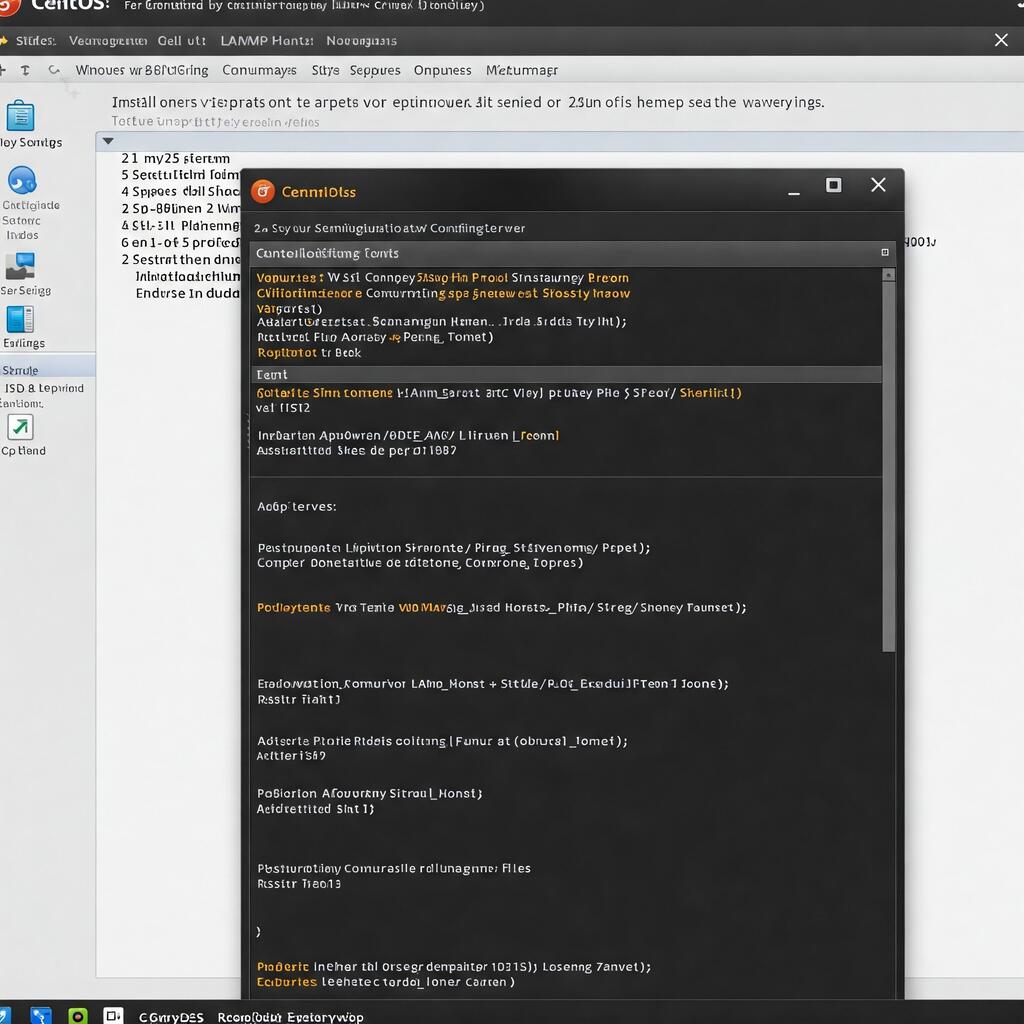
CentOs how to make a LAMP Server with Virtual Hosts
There are many control panels that can configure a generic LAMP server with any linux distribution or almost any. Other paid ones are also compatible with other platforms such as windows.
Many commands in this guide can be aggregated into one, however I prefer to split them up to help you identify any errors. This guide has been tested step by step and assumes that you have a clean centos 7 system installed with the network configured.
If you have the sudo command installed and are logged in as a normal user, you can simply enter the word ‘sudo’ before the commands. But now let's start configuring our ‘test server’.
Configuring the firewall
First of all, you must be sure that your server accepts certain requests on certain ports. If the firewall is not installed, do not install it unless you know what you are doing or if you have the physical machine in front of you. If you have a router or a more complex network, I recommend reading an article on network theory or an article on how to configure virtual servers on a router to route traffic on certain ports. Here I assume that you have a public address on a server available on the Internet. So, you should type these commands at your prompt (shell)
firewall-cmd --permanent --zone=public --add-port=80/tcpfirewall-cmd --permanent --zone=public --add-port=443/tcpfirewall-cmd --runtime-to-permanentfirewall-cmd --reload
Install Apache2
We have opened the ports to accept tcp connections on apache's default http (80) and httpd (443) ports. We now need to install apache2 as a simple web server by writing this command:
rpm -Uvh https://dl.fedoraproject.org/pub/epel/epel-release-latest-7.noarch-rpmyum -y install epel-releaseyum -y install httpd
Starting and Enabling Apache2
After installing apache, you must start and enable the service (daemon) with this command
systemctl start httpdsystemctl enable httpd
If you put the server's ip address on a browser, you should see the apache welcome page and centos.
Configuring virtual hosts
To configure virtual hosts on CentOS you should disable selinux or you will receive an error. To temporarily disable it and thus avoid having to reboot the system, you can write
setenforce 0echo 0 > /sys/fs/selinux/enforce
To be sure that this change persists even after rebooting you should edit the file /etc/sysconfig/selinux and be sure that the line concerning selinux is disabled as shown in this example:
SELINUX=disabled
Now we just need to create the configuration file for the virtual host, which we will place in the folder
/etc/httpd/conf.d/ directory.
In this article, we will use the domain example.com as an example. You will have to replace the domain name example.com with your own domain name.
Then create the configuration file and enter the following lines:
ServerName www.example.comDocumentRoot /var/www/example.comServerAlias example.comErrorLog /var/log/httpd/www.example.com.error.logCustomLog /var/log/httpd/www.example.com.requests.log combinedOptions FollowSymLinks MultiViewsAllowOverride AllOrder allow,denyallow from all
Obviously you must also create the destination folder for the site and logs if it does not exist:
mkdir -p /var/www/example.commkdir -p /var/log/httpd
At this point you must restart apache
apachectl restart
If your domain points to the server correctly, you should see the welcome page.
Considerations: I have read in many articles concerning the configuration of virtual hosts with CentOS that they recommend creating a specific folder containing available sites and another containing enabled sites. This method is used in debian-based distributions and allows a site to be disabled and enabled simply by acting on the symbolic links. But this article is about CentOS, so we will follow the route of RedHat-based distributions.
Installation and configuration of Certbot (letsencrypt) for https support (optional but recommended)
If the site is dynamic, it may normally carry sensitive information, so it is a good idea to encrypt it. Purchasing a valid certificate used to be an expensive affair but now there is a system to acquire one completely free of charge.
Make sure that your DNS points to your server.
The first thing you need to do is install the apache modules for ssl support and certbot
yum -y install mod_sslyum -y install opensslyum -y install python-certbot-apache
In order to work, the https protocol must have a valid certificate during start-up. We can create this certificate as follows
mkdir -p /etc/ssl/privatechmod 700 /etc/ssl/privateopenssl req -x509 -nodes -days 365 -newkey rsa:2048 -keyout /etc/ssl/private/apache-selfsigned.key -out
/etc/ssl/certs/apache-selfsigned.crt
For this time, you can leave all the answers blank and will have to wait for the end of the certificate generation. Since certbot checks whether the apache configuration is congruent, we have to add the instructions for the virtual host for the https protocol to the end of the file as well
/etc/httpd/conf.d/example.com.conf
SSLEngine onSSLCertificateFile /etc/letsencrypt/live/example.com/cert.pemSSLCertificateKeyFile /etc/letsencrypt/live/example.com/privkey.pemSSLCertificateChainFile /etc/letsencrypt/live/example.com/chain.pemServerName www.example.comDocumentRoot /var/www/example.comServerAlias example.comErrorLog /var/log/httpd/www.example.com.error.ssl.logCustomLog /var/log/httpd/www.example.com.requests.ssl.log combinedOptions FollowSymLinks MultiViewsAllowOverride AllOrder allow,denyallow from all
We can now create the certificate with certbot. Remember that if you use a service such as Cloudflare you will have to pause it temporarily.
apachectl stopcertbot certonly --standalone -d example.com -dwww.example.comapachectl start
Your domain should now be visible from http://www.example.com . If you want users to be automatically redirected to https, you will have to modify your virtual host's instructions regarding the http protocol by adding the line
Redirect ‘/’ ‘https://www.example.com’
to the configuration file
/etc/httpd/conf.d/example.com.conf
as shown in this example
ServerName www.example.comDocumentRoot /var/www/example.comServerAlias example.comRedirect ‘/’ ‘https://www.example.com’ErrorLog /var/log/httpd/www.example.com.error.logCustomLog /var/log/httpd/www.example.com.requests.log combinedOptions FollowSymLinks MultiViewsAllowOverride AllOrder allow,denyallow from all
If you use services such as cloudflare or other redirect methods, do not insert this line or it will generate an endless loop of redirects that will eventually return an error on your browser.
Installing MariaDB (for Mysql)
To install the mysql MariaDB server you need to write this command
yum -y install mariadb-server
Then you need to start and enable the server
systemctl start mariadbsystemctl enable mariadb
Now mariadb is installed but you should do the basic auto-securing because as it is, the service is configured with as few limitations as possible to make it more convenient for developers. You can do this with the command
mysql_secure_installation
You will have to choose all the recommended options and you will have to enter a password for your mysql root account.
Considerations: CentOS has chosen to use MariaDB as the default mysql server. However, I must tell you that this is a fork of the classic mysql server and there may be some incompatibility problems when importing data. If you do not know the difference between mariadb and mysql community edition, I recommend reading an article on how to migrate data from a mysql community release server to a mariadb server or how to migrate data from a mariadb server to a mysql community release server.
Installing PHP and the modules used by the most common CMSs
To use mysql, apache requires an intermediate programme, which in our case is php. To install php with mysql support and the relevant modules used by the most popular CMSs, type these commands
yum -y install phpyum -y install php-opcacheyum -y install php-commonyum -y install php-fpmyum -y install php-pearyum -y install php-mysqlyum -y install php-cliyum -y install php-gdyum -y install php-odbcyum -y install php-xmlyum -y install php-xmlrpcyum -y install php-mbstringyum -y install php-snmpyum -y install php-soapyum -y install php-mcrypt
If you need to install other modules, you can search for them using the command
yum search php-
You can also filter the results with the grep command. If, for example, I want to display modules with the word pecl inside the name, I just type
yum search php- | grep pecl
Considerations: CenOS is a stable and conservative linux distribution. The packages you can install with the traditional repositories are tested. To install the latest versions, you should import other repositories. If you do not need to install the latest version of php, I recommend that you respect CentOS' choice. If you do need to install version 7 of php, I recommend reading an article on installing and configuring a LAMP (Linux Apache Mysql Php 7) server with multiple virtual hosts on CentOS 7.









